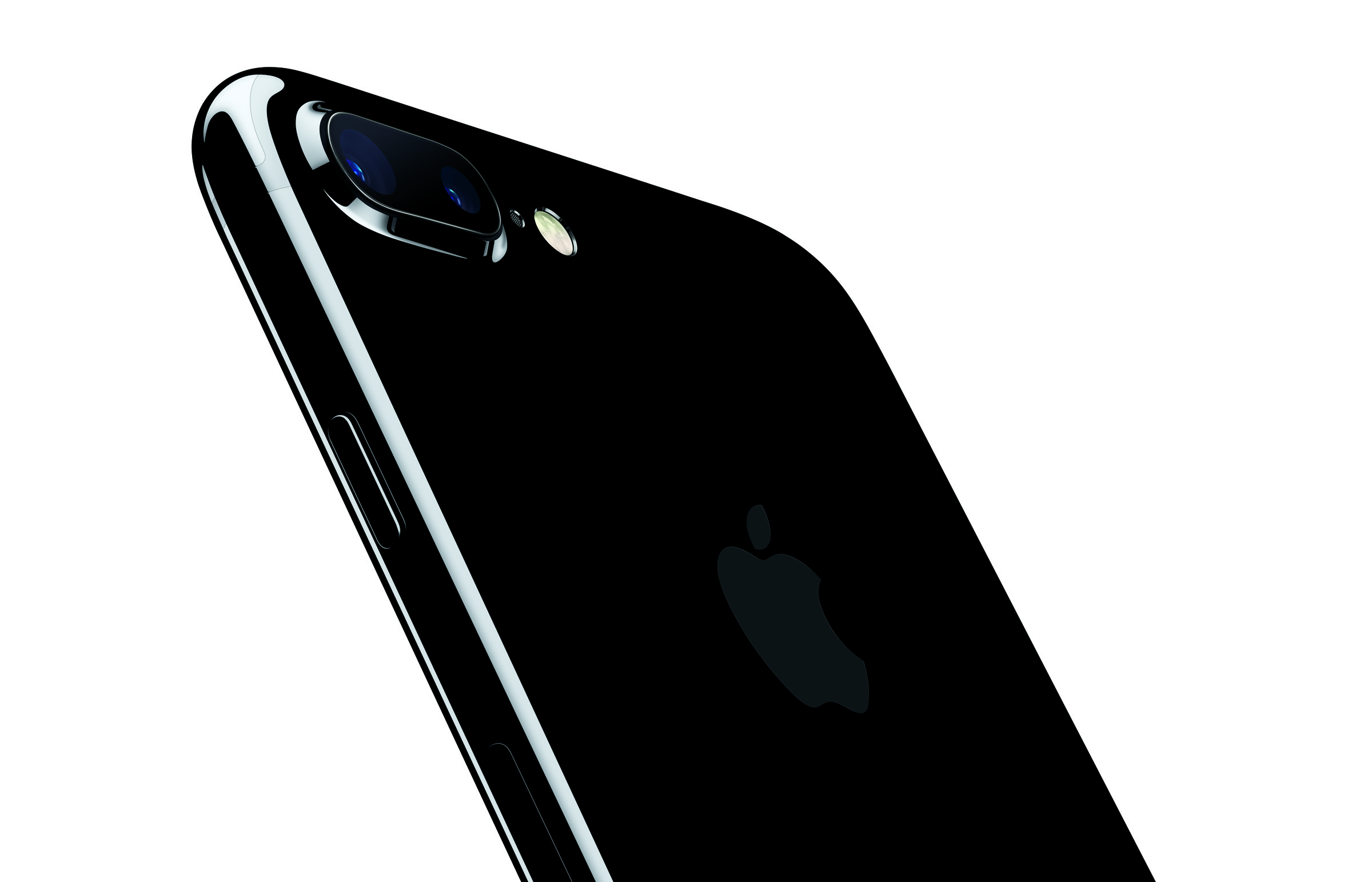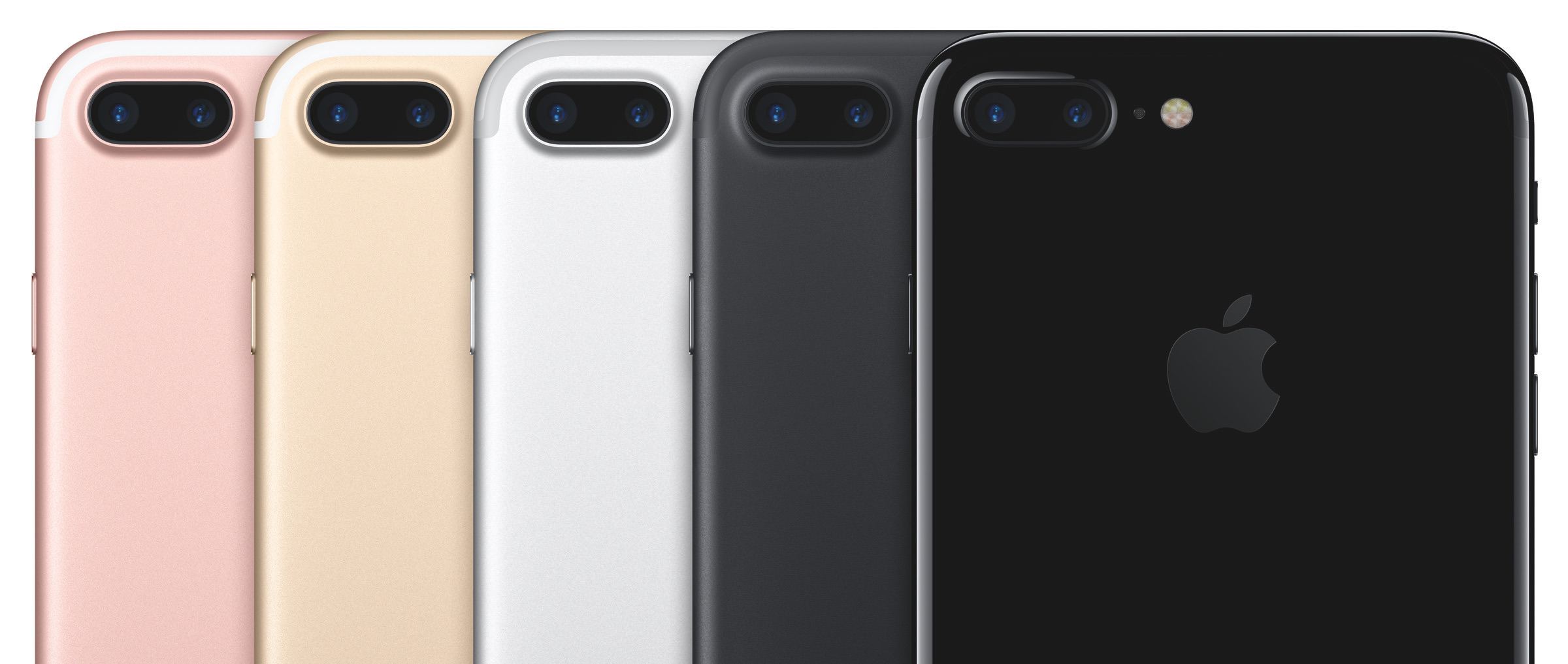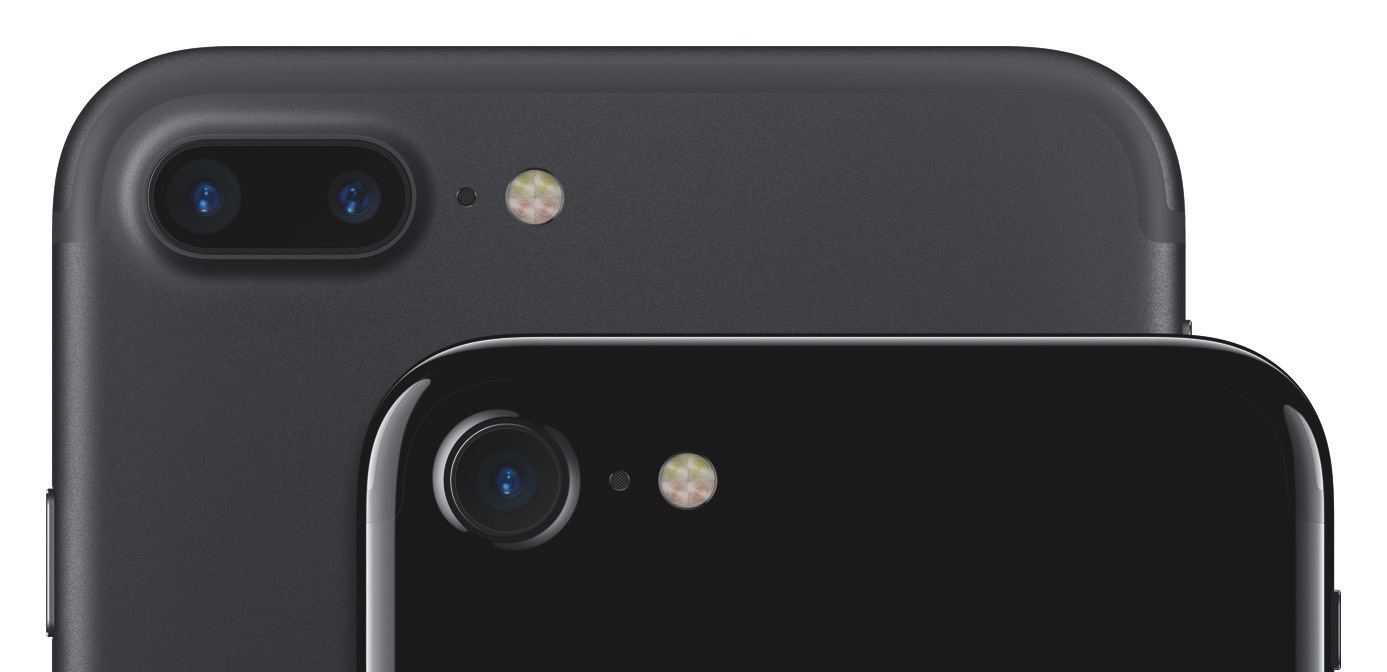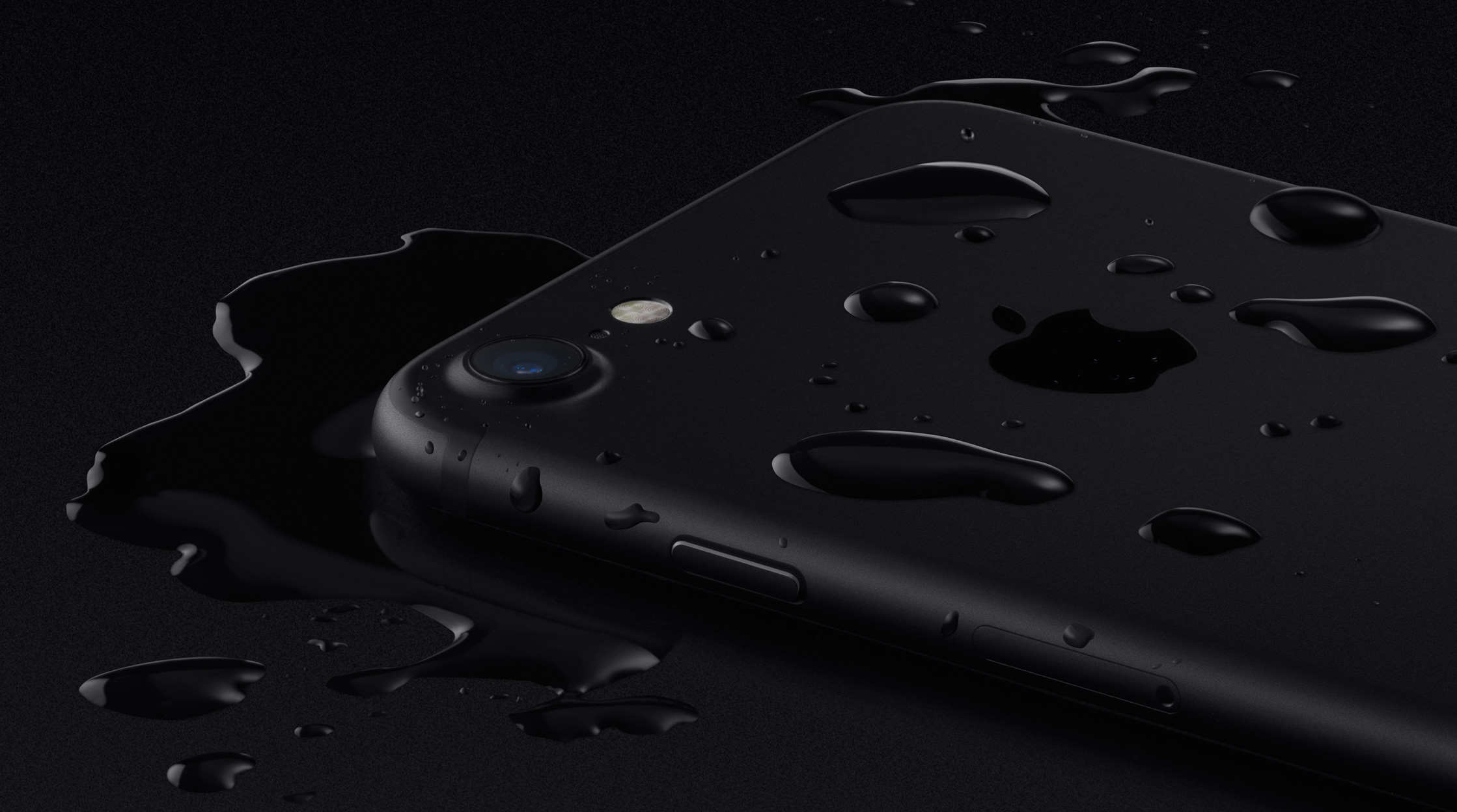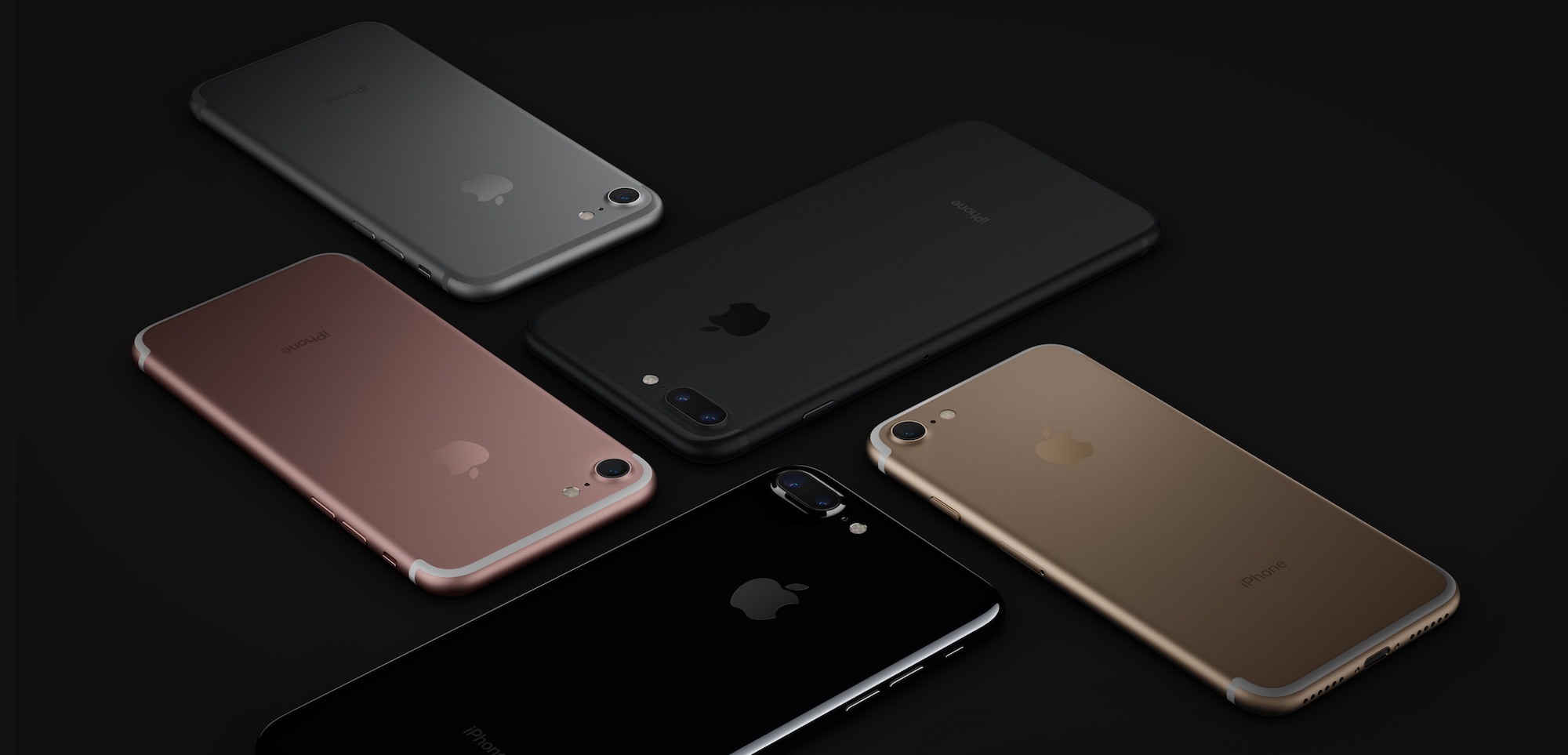Today during Apple’s keynote event at the Bill Graham Civic Auditorium in San Francisco, the Cupertino company announced the latest iteration on their most successful product. Despite rumors of a mostly laid back upgrade year, the iPhone 7 did not disappoint. While only minor changes have been made to the enclosure, there are significant upgrades to almost every other aspect of Apple’s flagship iPhone.
Design
While the general dimensions of both the iPhone 7 and the iPhone 7 Plus have remained the same, the camera footprint on both devices has increased. This means that most cases for the previous iPhones will likely no longer fit, unless they happened to leave a lot of extra space around the camera.
That said, the design of both phones have changed in more minor details as well. The cameras on both devices now include a slight taper leading up to the lenses, and the antennas on the devices have been redesigned so that the lines across the backs of the devices are no longer visible.
The Home button has been completely redesigned as well, although there are no visual indications of this from looking at it. The new home button is a solid-state button, meaning it is no longer mechanical. This will certainly make it much more durable than previous versions with their moving parts, and definitely helps with water resistance. It also means that the feedback felt from pressing the button is now tied to the iPhone’s Taptic engine, allowing you to configure how sensitive you want your Home button to be. The general idea sounds very similar to that of Apple’s Force Touch trackpads, which do not actually move, but use haptic feedback to make it feel like they’ve moved. We’ll see when the hands-on reviews start dropping whether Apple has succeeded with this goal.
Finally, with the iPhone 7 Apple is introducing two brand new colors for iPhones: Black and Jet Black. Black is the replacement for Space Gray, which is no longer an option for the newest iPhones. It is a black matte finish with a black Apple logo in the middle. The Jet Black color is a highly polished glossy black, harkening back to the shiny black glass of the iPhone 4 and 4S models. The Apple logo in the center of the Jet Black model is a dark gray.
Besides the new colors, new camera on the Plus models, and the modest design tweaks, it will be hard to easily spot a new iPhone 7 from an older 6 or 6S. This is the first time Apple has dubbed an iPhone with a completely new number without a full redesign of its exterior, but there are certainly many other changes to this device that make the digit change seem warranted.
Cameras
Both models of iPhone 7 include a brand new 12-megapixel camera with a larger ƒ/1.8 aperture and 6-element lens. Furthermore, for the first time the smaller 4.7-inch model has received the Optical Image Stabilization capability, which has been reserved for the larger model since the iPhone 6 series. Both cameras also can capture a wider color range, allowing for more vibrant and detailed color to be captured, and both include a new Image Signal Processor, which can process over 100 billion operations on a photo within 25 milliseconds.
Besides the back camera, both new iPhones also come with an upgraded 7-megapixel FaceTime camera on the front, which includes the wide color capture that’s new in the back cameras as well. The True Tone flash has been upgraded as well, now sporting four LEDs rather than the previous two, resulting in a 50% brighter flash. Apple has also added a sensor that detects the flickering of artificial lights and tries to compensate for it in photos and videos (if you’re not aware of this flickering, try taking a slo-mo video of an artificial light and you’ll see it).
For the iPhone 7 Plus, alongside the wide-angle camera specified above is a second camera, which has a 12-megapixel telephoto lens. Together, the wide-angle and telephoto cameras in the iPhone 7 Plus are capable of 2x optical zoom, and 10x digital zoom, while still maintaining the quality of the captured photo.
The final feature of the iPhone 7 Plus’ camera is the ability to perform an effect called “bokeh”, which is a photography term for images where the foreground is sharply in focus while the background is greatly blurred. The Bokeh effect is extremely difficult to achieve for smartphone-sized cameras, but Apple has managed it, sort of, with their new dual-lens system.
I say sort of because the feature will be fairly limited when it is rolled out, and it is only achieved via a combination of hardware and software working together. At its introduction, this feature will only be available via a special “portrait mode” in the iOS Camera app on iPhone 7 Plus. In portrait mode, a combination of hardware and software will use facial recognition to determine a person, or people, to focus on in the foreground. It will then defocus the background based on its knowledge of the subjects of the picture. The biggest limitation here is that the feature only works on human subjects (at least based on the information we have about it from the keynote). That means you can’t get the bokeh effect on subjects such as flowers or other inanimate objects, only on literal portraits you’re taking of people. Furthermore, in portrait mode, Live Photos are disabled, and you can’t take video using the effect.
All in all, the new bokeh effect may be extremely impressive technology to be included in the tiny camera of a smartphone, but it is also extremely limited technology at this time. It will be very exciting to watch Apple evolve and mature it, as they most certainly will in future generations, but for now its implementation remains a bit underwhelming. I expect it will be particularly so for people who do not understand the technical hurdles that the system is overcoming.
The final note about the bokeh effect is that the ability is not yet ready for prime time. It will not be included in the software for the iPhone 7 Plus at launch, but will instead be added at some point “later this year.”
Water Resistance
Another headline feature of the iPhone 7 is that it is finally officially water resistant. Note the difference here between water proof and resistant. The actual water resistance rating is IP67 under the EIC standard 60529. In normal terms, that means the iPhone 7 is certified to not break down to a depth of about 1 meter of water, and only for 30 minutes at that depth.
Obviously, this is a far cry from being truly water proof, but it does mean that you should no longer need to worry about a glass of water being knocked onto your iPhone, dropping it into a toilet or a pool (depending on the depth of the pool), using it while walking through the rain, etc. One important thing to note though is that Apple still advises against plugging in a wet iPhone to charge. If your iPhone 7 does get wet, shake it out and give it a while to dry out before connecting it to power. That said, a wet iPhone 7 should only be wet in the port and speaker areas, not throughout the entire phone, so it should dry out significantly quicker than you may be used to from previous generations. The days of leaving your iPhone in a bowl of rice should thankfully be over.
The iPhone may still be a couple years out from being being certified for use by scuba divers, or being dropped into a deep lake, but the important thing to know right now is that you are finally clear to snap some underwater selfies without sealing your iPhone in a plastic bag.
Stereo Speakers
The new iPhone lineup for the first time includes a set of stereo speakers, one located at the bottom and one located at the top. The speakers are not only two times louder than the old iPhone speakers, but they work together to offer higher dynamic range and higher quality sound.
There’s not much else to say about the iPhone’s speakers except that this is an extremely welcome change. The iPhone has been in need of a speaker upgrade for years, and the stereo system on the iPhone 7 seems to be as good as anything we could have hoped for.
iPhone, Sans Headphone Jack
Apple spent a surprising amount of time addressing the removal of the headphone jack during the keynote. I won’t go into all of it, but more or less it could all be summed up to “wireless is the future”. Apple truly believes that the way forward is the removal of wires, so it’s taking a bold step in this direction by removing the most ubiquitous port in technology’s history. Whether or not this is the right move, I’ll leave up to you.
For the iPhone 7, Apple has taken the least controversial route possible here. While they will certainly take a huge amount of heat for removing the port at all, they have tried to compromise at least a little bit by including a Lightning to 3.5mm headphone jack adapter in the box for all new iPhones 7. This means that any peripherals you currently use that plug in through the headphone port will still work, you just have to connect them via the adapter and through the Lightning port. The obvious downside here: you won’t be able to charge your iPhone while using the port (at least not without some other kind of adapter that allows both, but Apple is not currently offering one of these).
Another piece of the puzzle: for the headphones that ship with your iPhone, Apple is including a set of new Lightning connected EarPods in the place of their previous analog EarPods. These too will prevent you from charging while you listen to audio from your device, a seemingly important use case which Apple didn’t mention in its discussion of technology’s future. Probably because they’re hoping everyone will purchase the last new product which was announced this morning.
AirPods
Yes, as the rumors (sort of) predicted, Apple is also releasing a new line of entirely wireless headphones. Dubbed “AirPods”, these new devices consist of a charging case and two completely independent headphones, one for each ear. The AirPod exterior design is almost exactly what would happen if you sliced the ends off of your current Apple EarPod headphones. On the interior, however, the devices are really quite impressive.
Apple’s AirPods are Bluetooth connected headphones, but on the interior they include a brand new Apple-designed “W1” chip. The W1 is used to facilitate the interaction between the AirPods and a variety of connected devices, providing high quality sound, long battery life, and automatic setup of connections.
The “long battery life” is absolutely a relative term here. AirPods have long battery life relative to other objects small enough to fit in your ear which also need to facilitate a constant Bluetooth connection and stream audio without latency. In real-world terms, Apple sets the battery life for their AirPods at 5 hours per full charge. The battery charging case that comes with them holds a charge as well, and is capable of giving the AirPods a full 24 hours of playback time. However, this means that each time the AirPods run out of power they need to be recharged via the battery case before they’ll be ready to keep going.
I was hoping for the same quick-charging capabilities that we’ve seen from the likes of the Apple Pencil or the Magic Keyboard and Trackpads, where mere seconds of charging results in an appreciable amount of use. We didn’t quite get that, but for devices that charge inductively rather than via a hardwired connection, it’s not too bad at all. According to Apple, placing the AirPods in their charging case for 15 minutes will result in a 3-hour charge.
If your AirPods die in the middle of something, 15 minutes is quite a long while to wait before picking back up where you left off. (I suppose you could do a shorter time to get less than 3 hours, but anything more than 1 or 2 minutes is already extremely disruptive in such a situation, so the distinction doesn’t seem particularly important.) That said, if you keep in mind that at some point between each three-hour block of usage (or five-hour after a full charge) you need to find some time to drop the AirPods back into their case for a bit, it seems like it won’t be too big of a problem. Throughout everyday life I think the AirPods will work fine with these specifications, it’s only in more intensive tests, such as long airplane rides, when the battery limitations of the devices might become particularly aggravating.
The charging case itself charges via a Lightning port at the bottom. While it holds enough charge to keep the AirPods going for 24 hours, Apple doesn’t mention how long the charging case itself will hold that charge. It seems like the safest bet will be to charge it nightly (at least if you use your headphones regularly each day), so that’s yet another device to add to the constantly increasing number of electronics that we have to charge up every day.
Battery life aside, one of the other big aspects that Apple touched upon was the idea of seamlessly transitioning between devices that you want to play audio from. There’s a lot to stand up to here, as an analog headphone can switch sources by simply swapping the plug from a phone to a Mac, or other device. For the AirPods, once they’re initially paired to each of your devices, you’ll be able to set the source to play through them straight from Control Center on iOS 10 or watchOS 3, or from the Volume menu in macOS Sierra. Not too bad, assuming every device you want to play from is made by Apple.
Speaking of pairing, Apple has made the pairing process for AirPods extremely simple, at least for pairing them with the iPhone 7. To pair a set of AirPods, simply hold them close to the iPhone and a view will show up asking you to confirm the connection. One tap and it’s done.
This looks like a fantastic workflow to facilitate the usually fiddly process of connecting Bluetooth devices. The only caveat is that it’s likely something special that happens between the iPhone 7 and the AirPods. This means that connecting a set of AirPods to any other devices besides an iPhone 7 will probably fall back to the standard Bluetooth device pairing process. Once paired though, swapping input sources between different Apple devices should hopefully be as easy as Apple claims it to be.
AirPods do more than just play audio. Each pod also includes a microphone, so they can pick up audio input from your voice as well. This means you can take calls on your AirPods, as well as interact with Siri through them. Siri is activated by a double tap on one of the AirPods while it is in your ear. Once activated, the AirPods use accelerometers to tell when you are talking, and when you are it enables a pair of beam-forming microphones to focus in on your voice. This process supposedly filters out background noise so that your words come through much clearer than with previous normal headphone microphones.
The AirPods do not support a tapping interface for playback controls, but do make clever use of their ability to detect whether they are in your ears. With this, when you remove the AirPods they will pause playback, and this happens even if you only remove one AirPod. This way, if you need to have a conversation with someone, just pull one AirPod out of one ear while you’re talking. When you’re finished and want to listen to whatever audio was playing again, simply replacing the AirPod will automatically start playback again.
While I do wish there was some way to handle skipping forward or backward, for me I already automatically remove one headphone anytime I’m going to have a brief conversation with someone. I do this particularly frequently when ordering food somewhere, and I always pausing my audio first, then remove the headphone. Later, I replace the headphone and restart my music from the playback control. Combining these actions into one seems like a fantastic move, and I look forward to finding out how well it works in practice (this will mainly be a question of responsiveness).
Sadly, I’ll be looking forward to that for quite a bit longer than the release date of the iPhone 7. AirPods, which will be sold separately from the iPhone for $159, are not going to be released until late October of this year. That means we’ve got a few months to wait until we can see firsthand how well Apple’s newest foray into headphones will work in our everyday lives.
Performance and Battery Life
The final aspect of the iPhone 7 is, of course, the performance and battery life section. Surprisingly, there is more news this year for battery life than “it matches the battery life of last year’s iPhone.” In fact, the 4.7-inch iPhone 7 is going to be packed with a full 2 hours of extra battery life, on average. Besides the leap in battery life of the iPhone 6 Plus two years ago (not surprising given its larger enclosure), this is the first real jump forward in iPhone battery life since its introduction. According to the comparisons on Apple’s website, this change now places the iPhone 7 at approximately the same battery life expectations that Apple makes for last year’s iPhone 6S Plus model.
For this year’s iPhone 7 Plus, there has also been a battery boost, although only of 1 hour, on average. Every hour counts, so that’s great news too. Overall, the smaller model has now closed the gap on the larger model to only 1 hour of battery life between them. Great news for those still holding out from joining the Plus Club.
On the performance front, it’s no surprise that the iPhone 7 makes huge leaps once again. Within it lies Apple’s brand new A10 Fusion chip, which is faster and more efficient than any previous iPhone to date. The A10 Fusion chip is designed with four cores, two used for high performance and two used for high efficiency. This allows the chip to dynamically change between high performance when it’s needed, and energy efficiency when it’s not. That in turn contributes to the extra hours of battery life on the iPhone 7, but does lead me to wonder whether those battery life claims hold up under heavy usage, or if keeping the high performance cores running more than “average” will negate any supposed gains. Once again we’ll need to wait for some reviewers to get their hands on the devices to know this for sure. Regardless, under standard everyday use, it sounds like the new A10 Fusion’s intelligence could be a big boon for battery.
On the graphics front, the A10 Fusion chip has made significant improvements as well. It runs up to 3 times faster Graphics than the iPhone 6, and significantly faster than the iPhone 6S as well.
Finally, capacity. And here we can all let out a collective sigh of release, because with this year’s iPhone lineup Apple has finally said goodbye to the 16 GB base configuration. Apple’s iPhones now start at 32 GB for the base model, then jumping to 128 GB for the mid range model, and topping out at a huge 256 GB on the high end. Each jump is, as usual, separated by $100 each.
Also of significant note here, is that Apple has even increased the low end of capacity on last year’s iPhone models. Both the iPhone 6S and 6S Plus start at a baseline of 32 GB, along with the option for a single price bump to a max of 128 GB. The only iPhone left out of the capacity bumps is the iPhone SE, which remains available at the capacities of either 16 GB or 64 GB.
Wrap Up
All things considered, the iPhone 7 surprised me with its impressive repertoire of improvements. For a year that wasn’t expected to blow anyone away, the sheer number of changes have revealed an overall extremely appealing product. Maybe Apple has been saving the low hanging fruit upgrades like increased battery life and stereo speakers for a year like this with neither breakthrough new tech like Touch ID or 3D Touch, nor a brand new design like previous full digit turnovers. Regardless, looking at the phone as a whole, I find myself very impressed and excited. New colors always help, too.
The iPhone 7 will be available for preorder starting at 12:01 AM PDT on September 9, and will ship the next week on September 16. The 4.7-inch model will start at $649 (or $32.41/month) for the 32 GB model, and increase by $100 increments (or about $4.16/month) for the 128 GB and 256 GB models. The 5.5-inch iPhone 7 Plus will start at $769 (or $37.41/month) and increase by $100 increments (still about $4.16/month) for the 128 GB and 256 GB models. The Jet Black color for both iPhone 7 and iPhone 7 Plus is only available at the 128 GB tier or higher.
You can also follow all of the MacStories coverage of today’s Apple’s keynote through our September 7 Keynote hub, or subscribe to the dedicated September 7 Keynote RSS feed.


